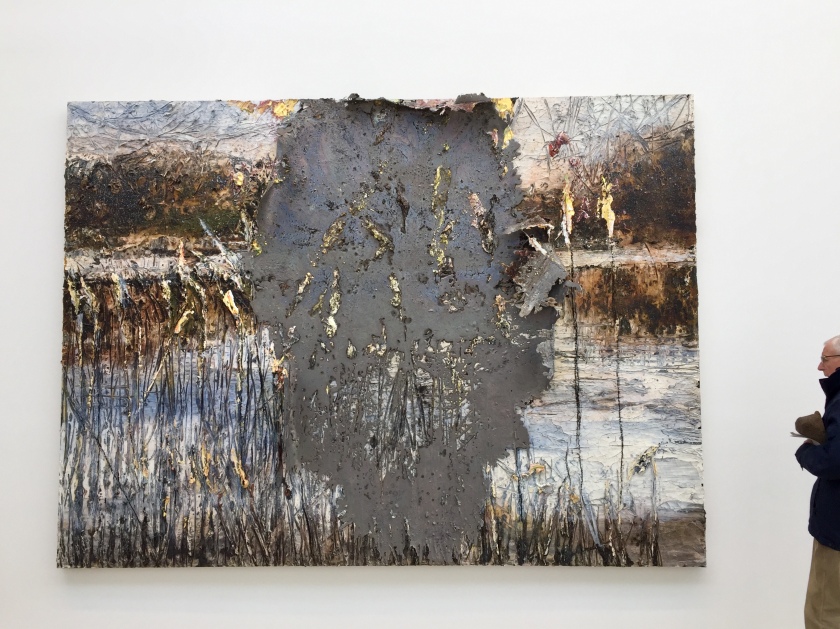A while ago I wrote a post about Anselm Kiefer’s paintings at the Musée Rodin (here).
The work had left me in awe of the artist’s scope and imagination and so I grabbed the chance to see the continuation of that work, at the Thaddeus Ropac gallery, in the Pantin area of Paris. The gallery is located in a former 19th century boiler-making factory and coppersmith’s workshop of about 4700m². This huge space, all red brick and brightness, enables them to accommodate monumental artworks they would be unable to present elsewhere.

Kiefer has for years made large scale paintings where the additions of broken glass, clay, and dried flowers or plants (especially sunflowers) result in encrusted surfaces and thick layers of impasto. For Kiefer natural materials such as straw, earth, and tree roots reference both time and patterns of life, death, and decay. However, recently the plants have mostly been replaced by resin copies, since curators and collectors were worried about the longevity of the art.

Below see a close up of the plants

Lead also has resonance for the artist both as a medium and a subject matter. It was the base material used in alchemy and he considers it the only material heavy enough to bear the burden of history. In this new work, he melts it, pours it over the paintings and then when it is nearly set he drags and twists it into curls, pulling away the layers underneath.

Because of his interest in mythology, history, and knowledge, Kiefer often uses books as subject matter representing knowledge and civilization. Similarly, he frequently incorporates text into his paintings, including excerpts from poems, novels, and nationalist slogans as well as names of seminal figures, written in a scrawling script.

Kiefer was born in March 1945 in Donaueschingen, two months before the end of World War II. His early childhood was spent in a devastated, bombed out landscape, which both provided inspiration and shaped his later development.

The artist is most known for his subject matter dealing with German history and myth, particularly as it relates to the Holocaust. These works forced his contemporaries to deal with Germany’s past in an era when acknowledgment of Nazism was taboo.

I remain fascinated by the sheer size and complexity of these paintings and installations, so I was interested to come across the video below, which shows a little of the process of creation.


Great coverage, Marina. i will try to visit TR in P
antin next time
LikeLiked by 1 person
It’s a must!
LikeLike
Those huge works are impressive indeed. Industrial in scale, and dramatic to see.
Best wishes, Pete.
LikeLiked by 1 person
“His early childhood was spent in a devastated, bombed out landscape…” is I think something that can help us begin to appreciate, or approach his works…
LikeLike
Certainly. And all that weight of history…
LikeLiked by 1 person
These works soothe my soul in all aspects . . . imagination, shape, colour, reality . . . Oddly, at the time of Anselm Kiefer’s birth, I was living as a tiny refugee tot but kilometres off Donaueschingen: when murder and rape and bombs are on the everyday agenda, they may leave an imprint on one’s life . . .
LikeLike
How interesting. Earlier works are a lot darker, more weighed by history. These are almost abstract, and refer to nature – the sea, sky, landscape, flowers. I think that’s what makes them soothing
LikeLike
Methinks we all have ‘my’ colours and ‘my’ shapes . . . . I would love to have his work on my walls and would probably smile just a tad every time I went past . . .
LikeLike
Well described and, particularly, photographed
LikeLike
I really appreciate your own work (photography included, as Mr. Knight pointed out), but also you interest in telling about and showing that of others. I don’t get to travel much, but posts like this enrich my life.
LikeLiked by 1 person
Thank you, Albert, I’m so glad you enjoy the posts. 🌺
LikeLike
To say Anselm Kiefer is a painter is to reduce paint to mud. He uses its fire and sets it ablaze with courage. He forces the viewer to look across the horizon and into history, beyond the mirror into the soul. Thank you, Marina, for giving us a chance to see his work.
LikeLiked by 1 person
I’m afraid the photographs leave a lot to be desired, given the paintings were so huge and I’m a terrible photographer, on an iPhone. Also the texture is difficult to describe, it’s so layered and complicated. But it does give you an idea. Definitely worth seeing, should you get a chance not too far from you.
LikeLiked by 1 person
You did a great job! You always do.
LikeLike